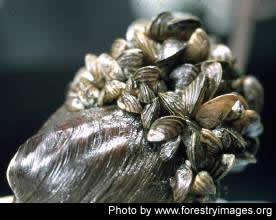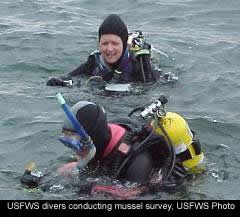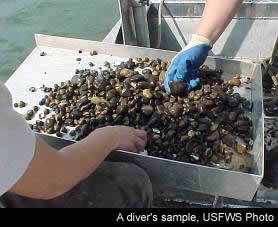

Attack of the Zebra Mussels! By Janet Butler We give each other a nod, release the air from our scuba vests, and slowly descend to the bottom of the Ohio River. There in the olive-tinged half-light, we lean forward, make eye contact and signal a mutual O.K. For the next hour, we will work in separate clouds of silt, digging riverbed samples from a prescribed pattern of ¼-meter squares. The crews in the boat above us wait for a tug on the line that signals it's time to haul a diver's sampling basket to the surface. They dump the wire basket's wet contents onto a sorting tray and train their eyes to see beyond the rocks and gravel. How many will there be this time? The two main answers might be expressed as, “lots of live native mussels—good; lots of live zebra mussels—bad.” Since 1995, a site at Muskingum Island in Wood County, West Virginia, has been a pulse-point of sorts for native mussel population health on the Ohio River Islands National Wildlife Refuge. Twenty-eight native mussel species live in the waters adjacent to the island, one of the richest areas of mussel diversity in the entire Ohio River. The federally endangered fanshell mussel occurs here along with more common ones known by quirky, descriptive names: monkeyface, fat mucket, washboard and three-horn wartyback, to name a few.
Refuge staff annually monitor densities of both native mussels and zebra mussels at this site with help from partners that include the West Virginia Division of Natural Resources. Zebra mussels were unknown on the refuge until 1993 when just one specimen showed up attached to a native mussel during surveys at Muskingum Island. Their numbers steadily increased until, by 1999, zebra mussel density peaked at over 10,000 per square meter around the island! How did they get here? It is thought that zebra mussels “hitch-hiked” on barges coming into the Ohio River sometime during the early 1990s from a source near Lake Erie . Native to the Caspian Sea, they probably arrived in the Great Lakes area in the mid-1980s in the ballast water of a ship originating from a freshwater port in Europe. Since then, the spread of zebra mussels across the eastern United States has been a phenomenal example of how a non-native organism can sometimes invade and overwhelm an ecosystem. As free floating larvae, zebra mussels must settle out and attach themselves to a hard surface in order to begin feeding. By producing their own waterproof glue, they secure themselves against water currents that might otherwise wash them away. This attachment ability may not work so well in the torrents of a free-flowing river, but in sluggish, dam-modified systems like the Ohio River, it is part of their ticket to success. Unfortunately, what is good for zebra mussels may be leading to an uncertain future for the native mussels of the Ohio River. Zebra mussels attach themselves to just about any stable hard surface available in the water: rocks, discarded cans or glass bottles, and native mussels. Once attached, they go about filter-feeding on plankton and other tiny food particles—the same food that nourishes native mussels. A native mussel probably would not be harmed much by one or two zebra mussels attached to its shell, but when hundreds take up residence, starvation of the native is a likely outcome. Annual zebra mussel monitoring surveys began at Muskingum Island in 1995. This monitoring includes assessment of the density and biomass (total live weight) of zebra mussels and native mussels. Until the year 2000, the trend in zebra mussel density climbed upward, from less than 10 per square meter in 1995 to over 10,000 in 1999! Although native mussel density showed more variability from year to year, a distinct decline in the numbers of live native mussels followed the rise of zebra mussels. By 2001, less than half the number of live native mussels were found around Muskingum Island than when monitoring began in 1995. Similar trends in the rise of zebra mussels and the fall of natives occurred throughout other monitoring sites along the Ohio River. Some monitoring locations in the lower Ohio River in Kentucky waters showed losses of approximately 90 percent of native mussels by the year 2000.
The Ohio River zebra mussel invasion came at the time when native mussels seemed poised for a strong future after decades of decline and general disregard. Improved water quality over the past few decades have allowed pollution-sensitive mussels and their fish hosts to return to the Ohio River from its less polluted tributaries. (Unlike zebra mussels, native mussels require fish in their life cycle to act as carrier hosts for their larvae.) State and federal regulations offered further protection. Do zebra mussels spell the end to this success? The answer is currently unknown. During the year 2000, a mysterious river-wide “crash” of zebra mussels occurred. At Muskingum Island, their densities fell by nearly 80 percent with further declines the following year to a drop of over 99 percent from their 1999 high—good news for native mussels in the short term at least. What caused this drop is unknown, perhaps attributable to disease, high flows, or a combination of factors. By 2003, however, zebra mussel densities were on the rise again at over 400 per square meter at Muskingum Island. High water in 2004 prevented monitoring, but it probably wasn't a good year for zebra mussels which do poorly when flows are strong. In 2005, partners from throughout the Ohio River watershed will join forces to revisit monitoring sites on the Ohio River. As the sampling baskets are lowered to the river bottom and the divers descend the depths of the Ohio, the question will remain the same—how many zebra mussels will there be this time? While no one is expecting the native mussels to be completely out of danger, those who have grown to appreciate these remarkable animals hope the returning basket samples will yield fewer zebra mussels and sustain the hope that native mussels are again poised for recovery. Janet Butler is an outdoor recreation planner for the U.S. Fish and Wildlife Service stationed in Parkersburg. What You Can Do... •Discard any unused live bait on land or return it to where it was collected. Thoroughly cleanse buckets and boats when going from one stream to another. Pests like the zebra mussel can be inadvertently spread by boats and in bait buckets. •Don't collect native mussels and report those who do to the Division of Natural Resources, 304-637-0245 or your local conservation officer. Also, be aware of any unauthorized stream modification activities in your area and report suspected toxic spills or illegal dumping of wastes to the Division of Environmental Protection. |


